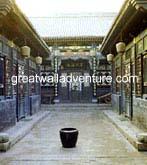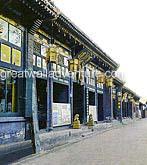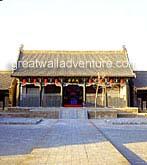Private Tour to Pingyao UNESCO Old Town:
3-day trip to Pingyao, Shanxi
heritage site from Beijing
Highlights:
� Discover the ancient town of Pingyao, one of the only
cities in China to maintain its ancient city walls and
streets. Being here will transport you back in time to
the China of yesteryear. The city is something of a
living museum
� Tour the exquisite ancient Buddhist temples of Pingyao,
which are haunting and captivating in their beauty, as
well as being a gateway to the ancient traditions of
China
� Your hotel will be in the style of a traditional
courtyard, giving you a much more intimate and memorable
experience than the normal hotel
(B=breakfast)
TOUR CODE:
PY-07
Why Pingyao Deserves Your Tour
Pingyao is a Chinese city and county in central Shanxi province.
It lies about 715 km from Beijing and 80 km from the provincial
capital, Taiyuan. During the Qing Dynasty,
Pingyao was a financial
center of China. It is now renowned for its well-preserved ancient
city wall, and is a UNESCO World Heritage Site. Pingyao still
retains its city layout from the Ming and Qing dynasties, conforming
to a typical Bagua pattern. More than 300 sites in or near the city
have ancient ruins. Preserved Ming- and Qing-style residences number
close to 4,000. The streets and storefronts still largely retain
their historical appearance.
The ancient city is in Pingyao County, Shanxi Province. The city
wall was first built during the Zhou Dynasty (11th century - 256
B.C.) and was expanded in 1370, the third year of the reign of
Ming Emperor Hongwu. Since 1997, it has been listed as a World
Heritage Site. Now Pingyao city is the only one in China completely
reserved as it was hundreds of years ago, no modern buildings, only
narrow stone-plate street with many Chinese-style shops on the two
sides.
"Pingyao, a UNESCO World Heritage Site, is an
exceptionally well-preserved traditional Han Chinese city. Its
city walls, old temples and courtyard houses were built in the
Ming and Qing dynasties. Located on the old trade route between
Beijing and Xi'an, Pingyao was one of the flourishing trade
centers in northern China. It was here, where China's first
banks were set up in the early 18th century which rapidly
developed into a widespread network of banks all over the
country. After its heyday the city fell into decline after about
1850, and its streets stayed unchanged since then because of the
lack of money for maintenance work. On this 4-day trip you will
not only visit the old town with its old streets and courtyard
houses complexes, but also Zhengguo Temple, Shuanglin Temple and
Jinci Temple.
DAY-BY-DAY DETAILED ITINERARY:
Day 1 Beijing-Pingyao (by train)
You will take the overnight train K603 (17:07-04:32) or 1163
(19:03-7:31) from Beijing to Pingyao. You will have a soft
sleeper compartment, so you will sleep in comfort and peace
during the trip.
Day 2 Pingyao (B)
Upon arrival at the train station, you will be met by your
local English-speaking guide, and he/she will take you to your
hotel, which is in the style of a traditional courtyard. For
much of today�s touring, we will be walking within the ancient
town of Pingyao, which is built in the style of traditional
Chinese urban planning, which includes 4 main streets, 8 narrow
roads, and 72 smaller lanes, all of which for a neat and logical
grid.
The three-story Market Tower is the center and joint point of
the city streets. The buildings such as Ancient City Government
seat, Town God's Temple, Confucius Temple, Military God Temple,
Wealth God Temple and Lucky Fortune Temple are arranged
symmetrically. With its main streets forming a "干"shape, there
are altogether four main streets, eight branch streets and 72
lanes in the city area. Having stood a long time
weather-wearing, all these buildings show no sign of
dilapidation. In front of the gates of some magnificent
buildings and grand shops, deep ruts on the ground are still
there to be seen, reminding visitors of its ancient busy traffic
and commercial situation. The streets in this ancient town are
broad and very well arranged. Dotted with memorial archways and
decorated gateways, stretching one after another and high and
low, the old houses and courtyards flanking the streets and
lanes remind visitors of the long past and their ancestral
places. Walking along the ancient streets, you seem to have
landed in a world beyond the present one. 18.5 meters in height,
and situated in the town center, the Market Tower is the highest
building within the main street from the south to the north
running through it. it is said the marketing was going on around
the Tower all day long, thus it was named the Market Tower.
Belonging now to the historical sites protected by the
provincial government, it was renovated in 1688 during the
Emperor Kangxi Period of Qing Dynasty, but people still don't
know when it was first built.
We�ll come across the Ri Sheng Chang bank, which was the scene
of China�s modern banking and commercial business. As early as
in 1824, Ri Sheng Chang bank had begun its business. Within a
few years of its founding, its branch banks were rapidly
distributed to Jiangsu, Shandong, Henan and Liaoning Provinces.
Branch banks were also set up in such big cities as Beijing.
Today, people can still trace its great prosperity of the bank
groups nicknamed as the "Asian Wall Street" from the remaining
bank and shop buildings along the West Main Street in ancient
Pingyao City.
You�ll have the chance to walk along Pingyao�s ancient city
wall, which is one of the only cities (along with Xian) in China
to have its city wall intact. Built with rammed earth inside and
brick and stone outside, the ancient city walls measure 10
meters high and 6162.7 meters long with 3-5 meters wide tops.
Except the southern wall, which zigzags a bit according to the
land contour, the other three walls all go straight, making the
city area a square one. One city gate was built each to the
southern to northern walls and two city gates were built each to
the western and eastern walls. All six city gates have gate
towers and inside gates attached to them. A watchtower was built
on the wall top every 50-100 meters away, totaling 72
watchtowers in all along the four walls. From the wall you will
have a great view of the ancient city center.
After exploring the ancient town of Pingyao, we'll return to the
hotel for the night, and you have the option of further walking
around the town at your own leisure.
Day 3 Pingyao-Taiyuan-Beijing(B)
After breakfast in the hotel, we will continue our touring in
Pingyao, with today focusing on the city�s numerous temples. Our
first stop will be at the Shuanglin Temple, which is just a
short drive outside the city wall, the Shuanglin Temple is
reputed to be the 'ancient painted sculptures museum'. The
temple houses more than 2,000 colorful sculptures reflecting the
exquisite skills of the artisans of the Song, Yuan, Ming and
Qing Dynasties. The Shuanglin Temple was included in the World
Heritage List by UNESCO as an important cultural site of Ping
Yao City in 1997. Having a history of over 1,400 years, the
Shuanglin Temple contains ten large and small halls, as well as
the sutra chanting hall and the monks� living quarters.
Will then head over to the Zhenguo Temple. The history of the
temple begins in 963, when it was recorded that Wanfo Hall was
built. The date is written on a beam in the hall, and is also
the date given by a local history of Pingyao county written in
the 19th century. A stela written in 1819 also confirms this
date. The temple contains two main halls and a gate, with two
courtyards in between the three buildings. There is a wall
surrounding the entire complex. The temple opens to the south,
with the Tianwang Hall acting as the temple�s gate. The next
hall, to the north, is the Wanfo Hall, and the final hall is
called Sanfo Hall, which dates from the Qing Dynasty The
northern courtyard also features two minor halls facing to the
east and west called the Gaunyi and Dizang Halls, which both
date from the Ming Dynasty There are also two bell towers
located on either side of the Tianwang Hall.
The most important hall in the temple is Wanfo Hall (Hall of
1000 Buddhas), one of China's oldest wooden buildings.
It is a three-bay single-eaves hip and gabled hall that is
nearly square in shape, measures 11.6 by 10.8 meters, and is 8.8
m high. Despite the building's small size, and features that
would identify it as a regular hall (such as pillars that have
been implanted directly into the floor instead of on a stone
pedestal), the structure is quite complex. There are doors at
the front and back of the hall. In addition, the front of the
hall has two windows on either side of the door. There are
twelve pillars supporting the structure. The corner and
column-top brackets holding up the roof are of the 7th degree,
the most complex and large type. These bracket sets are nearly
2.5 meters high � 70% the height of the columns. Inter-columnar
brackets that occur between every two pillars are of the 5th
degree. The hall has no ceiling, and the upper and lower set of
rafters are exposed.
Before your trip back to Beijing, we'll stop at one more temple,
the Jinci Temple. The Jinci Temple was first built during the
northern Wei Dynasty (386-535), the original name of Jinci
Temple is Tangshuyuci Temple. Being one of the rare large-scale
memorial temple gardens, it was built for memorizing Tangshuyu,
the seigneur who founds Jin state. The scenery of the Jinci
Temple Tourist Zone is beautiful. Palaces, pavilions and
bridges set off each other. The water runs surround the
pavilions, numerous cultural relics spot everywhere and the
ancient trees go into the sky. It is the outstanding
representative of the ancient gardens. Saint Mother Hall, the
Figures of the Maidservants, Yuzaofeiliang and the Never Aging
Spring are the pride of Jinci Temple. The Zhou Cypress, the
Never Aging Spring and the Figures of the Maidservants of the
Song Dynasty (960-1279) are regarded as �Three Great Things of
Jinci Temple�, which have high historical, scientific and
artistic values.
Besides the natural scenery of the beautiful mountain and water
scenery, the verdant ancient trees and the songs of the insects
and birds, Jinci Temple also has resplendent and magnificent
ancient architecture. The quality suggestive of poetry or
paintings makes people do not want to leave. It is not only a
component of the historical cultural heritages of our country,
but also reflects the immense wisdom and creativity of the
Chinese workers in ancient times. Jinci Temple is an ideal place
for relaxation, entertaining, seeking for quiet places and
exploring ancient relics.
You will then be driven to the Pingyao train station, where
you'll take a short train ride to the city of
Taiyuan. At
Taiyuan, you will transfer to the high-speed bullet train of
D204 (19:11-22:28), and you will arrive in Beijing that night.
 Ask a quick question here
or book a tour: Ask a quick question here
or book a tour:
|






|

